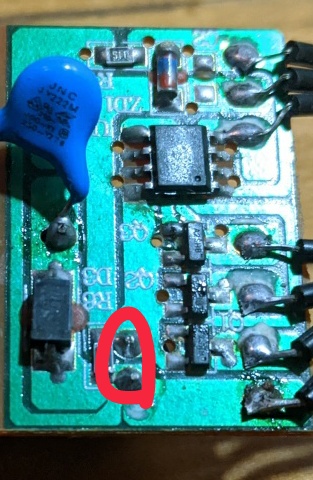hiya!
I got a cheap LED strip with PSU, controller, and IR remote. I didn’t look at it too much, figured it would be easy to stick it under my kitchen cabinets.
however, this thing blinks and fades and whatnot and I’m supposed to switch it over to constant light by repeatedly pressing the remote, which a) works shitty and also b) don’t wanna do that. I just want to plug it into power and it lights up and that’s the end of our interaction.
so, I opened up the PSU/controller and I’d like to locate the spots that give me +12V and GND and I can bypass the whole blinky fadey mess.


it’s a single-sided PCB. the top three wires on the right are for the IR receiver, ignore 'em. the bottom 4 are R, G, B, 12 V, respectively. I’m shorting RGB as it’s a white-only strip.
can you hazard a guess where I’m most likely to succeed?
deleted by creator
Thanks for the closure, glad you got it sorted! You might just need to change the batteries on your multimeter to get it back to normal.
deleted by creator
Bottom leg of the transistor to the left of the signal wires would be my guess for ground, do you have a multimeter to check?
Looks like a large ground plane to the left of the transistors, so you might be able to scratch away the coating and solder directly to it.
deleted by creator
You can’t check for ground specifically, you just check for a 12v difference between two points, and call those +12 and GND.
Feels odd that they are pulsing the entire 12v line, but I’m guessing it was something cheap.
The bottom leg of the transistor definitely looks like GND to me, so I think you just want to probe around (carefully!!) to find the stable 12V. I would avoid the entire live side, and for safety, might be worth taping it up.
If you cant find a stable 12v, you may want to get a cheap 12v power supply? Old laptops are often 12v, power too chargers as well are often 12v.
deleted by creator
Maybe you can trace that low voltage fluctuating line back to one of the ICs?, and work put how to disable that IC?
Or, use the remote to output solid white, and find the voltage on that line, and then try find that voltage somewhere else and short the two?
I’m running out of ideas though, I suspect buying a cheapo power supply might be easier :/
deleted by creator
Are you checking between the 12V and one of these legs? It’s typically connected to ground in these types of controllers. Here’s the SOT23 pinoutfor reference if that is the same package.
i’d check those two contacts.
with your description, the lower should be 12v and the upper gnd.
deleted by creator
is it fluctuating, because there is no load attached?
the fading as well as the color changing should be controlled by the three transistors next to the cables. the connections i highlighted are before those transistors, so there should be no fading at that point.
if it’s still fluctuating, if you have a load attached, i’d just go with some cheap 12v psu and call it a day.
My assumption with this PCB is that it switches the GND, meaning 12v is always provided to the LEDs. So the trick is to find somewhere that has a permanent GND and then connect all the LED leads to that. But I don’t see a large enough spot to land three new leads, except maybe where R6 is.
You’ll have to verify if my assumption is accurate, although I do wonder if you could just get a different PSU outright. This sounds like a 12v LED strip, so any sufficiently sized 12v wall-wart would also suffice.
Can you also clarify: you want this strip to be always-on and all-white, but the strip uses RGB LEDs? While it does produce white, it might not have a very high CRI and thus may be unpleasant for certain lighting applications. There are dedicated white LED strips which will perform a bit better for color rendition, and that could potentially be an issue if food needs to look appetizing under these cabinets.
deleted by creator
When you say all the LEDs light up, do you mean they light up white?
Those LEDs are labelled R G B, so I would have assumed they were single colour LEDs?
deleted by creator
Interesting, never heard of that arrangement before.
deleted by creator

